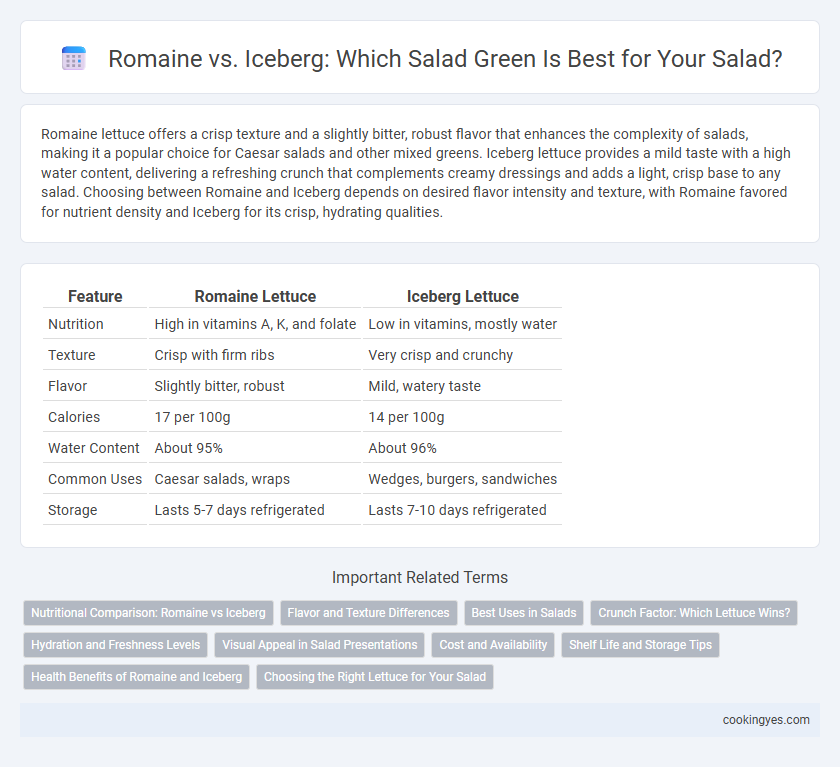Romaine lettuce offers a crisp texture and a slightly bitter, robust flavor that enhances the complexity of salads, making it a popular choice for Caesar salads and other mixed greens. Iceberg lettuce provides a mild taste with a high water content, delivering a refreshing crunch that complements creamy dressings and adds a light, crisp base to any salad. Choosing between Romaine and Iceberg depends on desired flavor intensity and texture, with Romaine favored for nutrient density and Iceberg for its crisp, hydrating qualities.
Table of Comparison
| Feature | Romaine Lettuce | Iceberg Lettuce |
|---|---|---|
| Nutrition | High in vitamins A, K, and folate | Low in vitamins, mostly water |
| Texture | Crisp with firm ribs | Very crisp and crunchy |
| Flavor | Slightly bitter, robust | Mild, watery taste |
| Calories | 17 per 100g | 14 per 100g |
| Water Content | About 95% | About 96% |
| Common Uses | Caesar salads, wraps | Wedges, burgers, sandwiches |
| Storage | Lasts 5-7 days refrigerated | Lasts 7-10 days refrigerated |
Nutritional Comparison: Romaine vs Iceberg
Romaine lettuce contains significantly higher levels of vitamins A, C, and K compared to Iceberg, making it a more nutrient-dense option for salads. It also provides more dietary fiber and antioxidants, which support digestion and immune health. Iceberg lettuce, while lower in nutrients, offers a higher water content that helps with hydration but lacks the substantial vitamin and mineral benefits found in Romaine.
Flavor and Texture Differences
Romaine lettuce offers a robust, slightly bitter flavor with a crisp and crunchy texture, ideal for adding depth to salads. Iceberg lettuce provides a milder, watery taste with a refreshing, crisp texture known for its high crunch factor. The distinct flavor intensity and firmness of Romaine contrast with Iceberg's subtle taste and lighter crunch, making each suitable for different salad styles.
Best Uses in Salads
Romaine lettuce offers a crisp texture and slightly bitter flavor, making it ideal for Caesar salads and mixed greens where a sturdy leaf is desired. Iceberg lettuce provides a mild taste and high water content, perfect for adding crunch to simple garden salads or as a base for heavier toppings. Both varieties complement different salad styles, with Romaine favored for hearty dishes and Iceberg suited for fresh, light preparations.
Crunch Factor: Which Lettuce Wins?
Romaine lettuce offers a satisfying crunch with its elongated, sturdy leaves that hold up well in salads, making it ideal for dishes needing texture and durability. Iceberg lettuce delivers a crisp, refreshing crunch due to its dense, tightly packed leaves, but tends to be more watery and less flavorful. When prioritizing the crunch factor alone, iceberg edges out with a sharper snap, while romaine provides a more substantial, lasting crunch perfect for heartier salads.
Hydration and Freshness Levels
Romaine lettuce contains higher water content, approximately 95%, compared to Iceberg's 92%, contributing to superior hydration and a crisper texture. The sturdy leaves of Romaine retain freshness longer under refrigeration, making it ideal for salads requiring prolonged crispness. Iceberg, while refreshing, tends to lose moisture faster, resulting in a quicker decline in freshness and crunch.
Visual Appeal in Salad Presentations
Romaine lettuce offers vibrant dark green leaves with a crisp texture, enhancing the visual appeal of salad presentations through its bold color contrast and elongated shape. Iceberg lettuce provides a pale green, tightly packed head that creates a uniform, refreshing backdrop but lacks the striking color vibrancy of Romaine. Combining both greens can create a visually appealing salad with varied textures and shades of green, elevating overall presentation.
Cost and Availability
Romaine lettuce generally costs more than iceberg lettuce due to its higher nutrient content and delicate leaves, which require careful handling and faster turnover. Iceberg lettuce is widely available year-round at lower prices because of its longer shelf life and robust nature, making it a budget-friendly option for salad greens. Both types are accessible in most grocery stores, but iceberg's consistent availability often makes it the preferred choice for cost-conscious consumers.
Shelf Life and Storage Tips
Romaine lettuce typically has a shelf life of about 7 to 10 days when stored properly in the refrigerator, while iceberg lettuce lasts slightly longer, around 10 to 14 days due to its higher water content and dense structure. To maximize freshness, store both types in a perforated plastic bag or a crisper drawer set to high humidity, avoiding excess moisture to prevent wilting and decay. Keeping romaine and iceberg separate from ethylene-producing fruits like apples or bananas helps extend their shelf life by reducing premature spoilage.
Health Benefits of Romaine and Iceberg
Romaine lettuce offers superior health benefits compared to iceberg, providing higher levels of vitamins A, K, and C, along with essential minerals like folate and potassium. Iceberg lettuce contains more water content, contributing to hydration but has fewer nutrients and antioxidants than romaine. Consuming romaine boosts immune function and supports bone health, while iceberg primarily aids in low-calorie hydration.
Choosing the Right Lettuce for Your Salad
Romaine lettuce offers a crisp texture and robust flavor rich in vitamins A and K, making it a nutritious choice for salads. Iceberg lettuce provides a refreshing, mild taste with a high water content that adds crunch while keeping calorie counts low. Selecting between Romaine and Iceberg depends on desired taste, nutritional value, and texture preferences to enhance your salad experience.
Romaine vs Iceberg for salad greens Infographic

 cookingyes.com
cookingyes.com